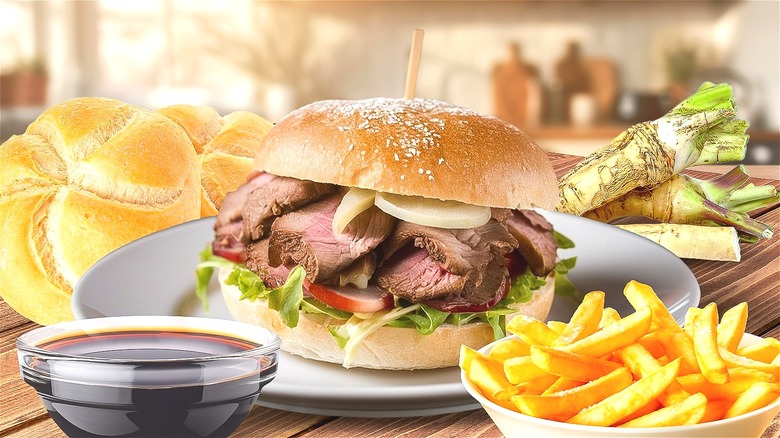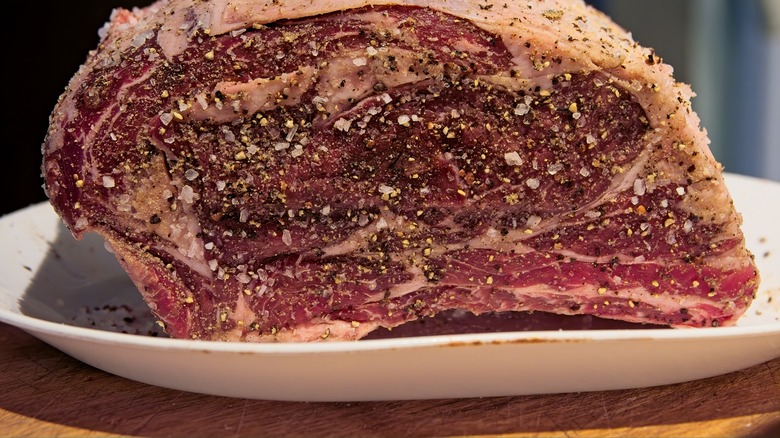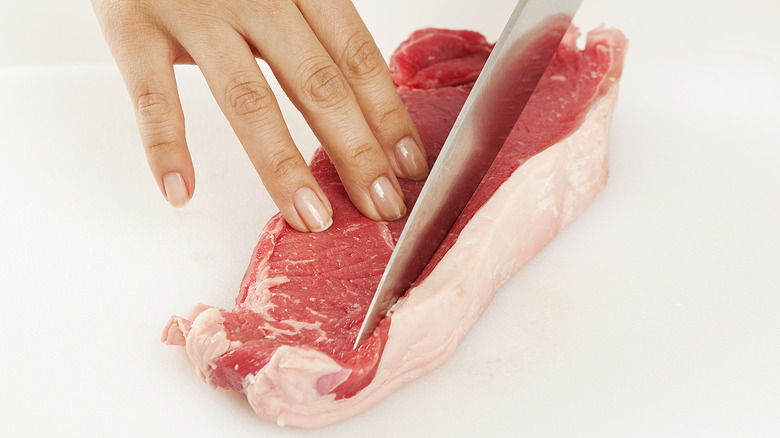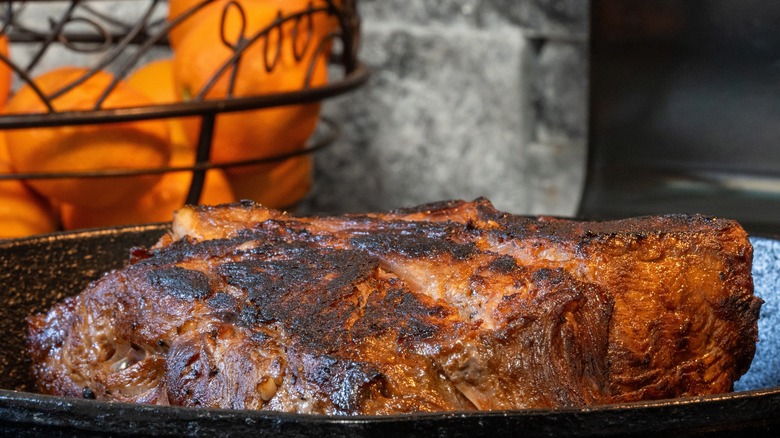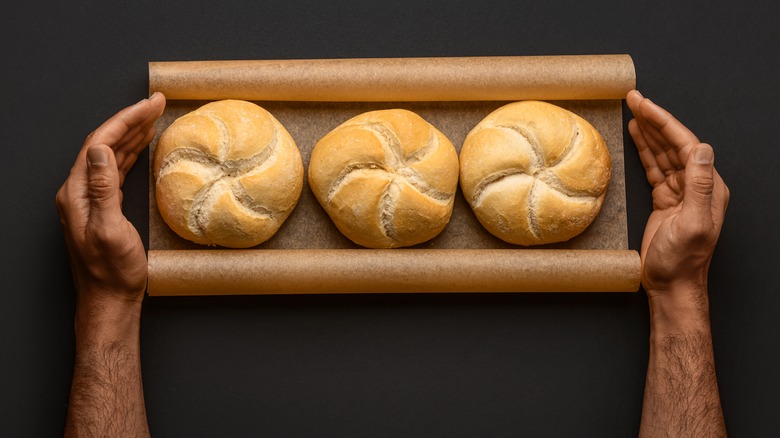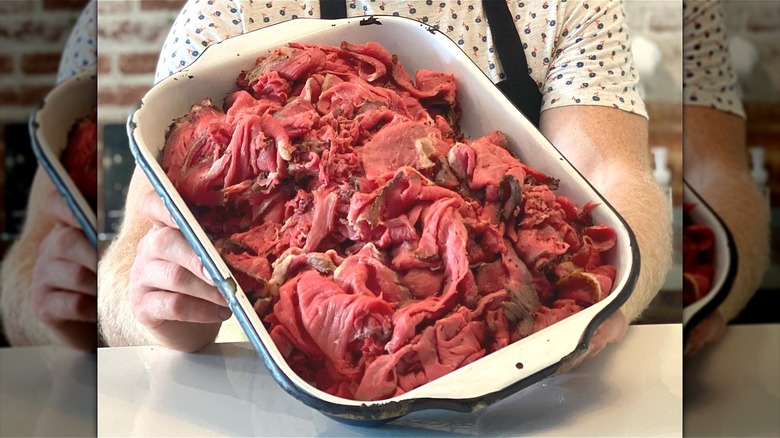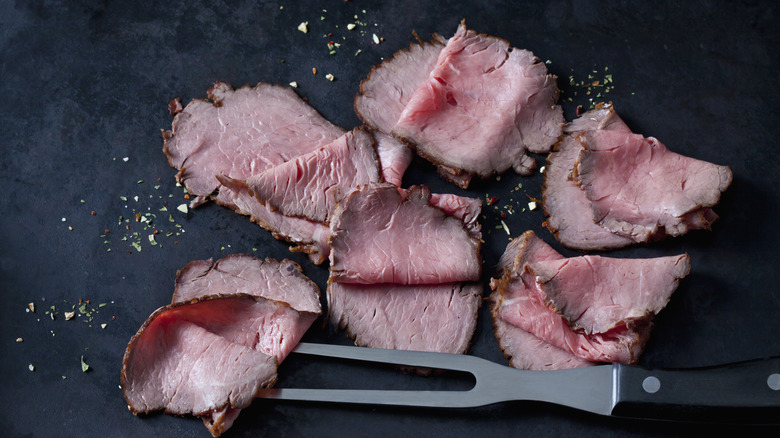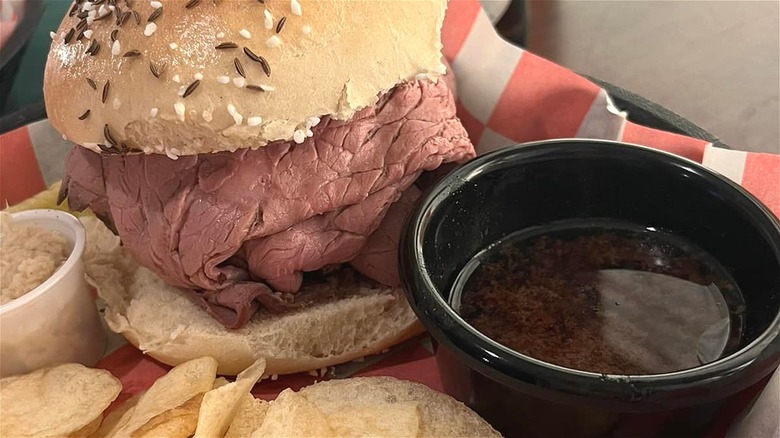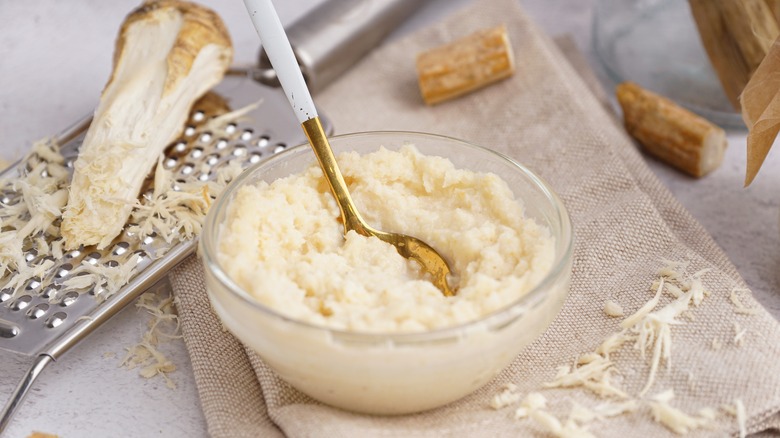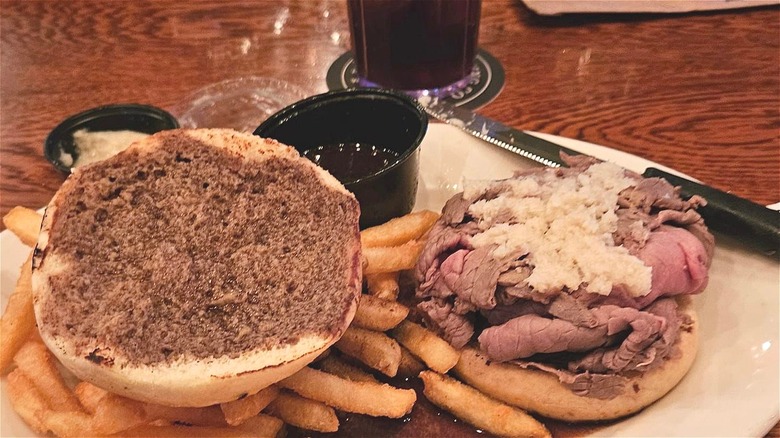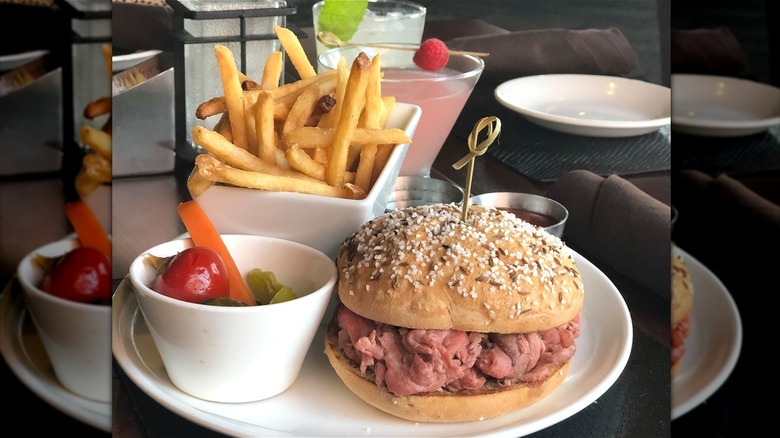11 Tips You Need To Make Beef On Weck
Go to any tavern in Buffalo, New York, and you'll encounter an enticing — and underrated — meat-on-bread delicacy. Beef on Weck is a sandwich, and it dates back to the early 20th century from the city's German communities. Consisting of roast beef, horseradish, and a luscious Au Jus within a Kummelweck roll, residents have largely kept the tradition alive in their own backyards.
Being hyper-local, the Beef on Weck is far less mainstream, especially when you compare it to the city's ultimate claim-to-fame, the chicken wing. We argue that's part of its underdog draw. Speak to Tom Moriarty, one of the co-founders of butcher shop Moriarty Meats, and he'll say the meaty sammie deserves a spot among the other great regional sandwiches of America (and beyond). "In our opinion, when it's done right, this Buffalo classic is right up there with a jambon-beurre."
It's very unique, savory, and teems with an umami funkiness, suggesting perhaps that this sandwich isn't easily replicable for foodies outside the East Coast. However, after talking to the experts, a few well-planned tweaks seem to make all the difference for a memorable dining experience. Receiving exclusive intel from two of the city's finest Beef on Weck purveyors, Chowhound is ready to lend you a hand in constructing this unique handheld at home. See how these legendary restaurants demonstrate sandwich excellence, with helpful pointers you'll have straight at your fingertips.
Purchase ultra-tender beef
Just about any kind of sandwich, regardless of the style, can be ruined by biting down into tough, rubbery meat. When building your own Beef on Weck, you want to ensure the beef you purchase retains a juicy, easy-to-slice consistency. Not every hunk of cow is going to fit the bill for the sort of slow-cooking that's needed for roast beef, so this requires selecting the proper cutlet. Experts will advise lean cuts of beef that are light on the fat, but as our demonstrated to Chowhound, there's room to pick more than one kind of variety.
Moriarty Meats constructs its sandwiches with a steak cut called top round, and it's popular due to its ability to simmer to softer, fall-apart proportions. Where chef Brian Mahony from Eckl's is concerned, prime rib — though pricier than other cuts — is a better option for assembling the Beef on Weck. "The Prime Rib lends superior flavor, and it is way more tender to eat," elaborates Mahony, mentioning that top rounds are hard to cut and get leathery. From a pro's perspective, it can't be emphasized enough: only the moistest, juiciest beef will do for a sammie this stacked.
Make sure to remove the fat
A touch of marbling running through your beef isn't a bad thing — it's a flavor-booster, and you'll want to leave it intact in order to, say, cook the perfect steak. For a Beef on Weck, however, experts are adamant on trimming every chunk you can. Pockets of excess gristle are not only unpleasant to eat, but they sabotages the meat's potential for a robust, full-bodied flavor. For example, ever notice that strange silver membrane coating the surface? Should you neglect removing it, any spice rub you apply to the exterior will not be able to seep in and activate during cooking.
Trimming the extraneous fat may take a bit of a learning curve, but it's a worthwhile effort to honoring the butchers of Buffalo who've mastered the cleaver to craft this iconic offering over a century prior. Moriarty Meats' co-owner Tom Moriarty goes to great lengths to slash off any tendon-y bits so that the surface is smooth and devoid of any filler. From that point on, your cutlet is ready for the heap of seasonings — and a sultry mouthfeel — that's yet to come.
Season simply and abundantly
Similar to a French Dip, Beef on Weck sandwiches require zero gimmicks or outlandish embellishments to get the mouth watering. The appeal is good bread, and good beef, whose quality will be obvious in every lip-smacking bite. When you get to flavoring your choice of beef, it's important to basic spices that won't overpower the sandwich's richer properties. Salt, pepper, and dry herbs (applied generously, of course) pack oomph while drawing attention to the sensational quality of the meats.
Some establishments keep it simple by choice, but readers will be pleased to know adjusting the spices to your preferences is always legitimate. Tom Moriarty from Moriarty Meats believes in high quantities of a single kitchen staple: "We like to keep it simple here –- salt, salt, and more salt!" Taverns like Eckl's, on the other hand, coat the protein with a blend consisting of additional, multi-layered nuances. "I dry rub my prime rib with granulated garlic and onion, dry thyme, salt, and pepper," notes Brian Mahony. The key difference between granulated garlic and garlic powder is the rougher finish that's suited well to withstanding extensive heat, especially in marinades and rubs, so give yourself permission to play around and experiment.
Cook the meat slowly for succulent texture
Doing the Beef on Weck well is an art. Like all culinary masterpieces, the process can't afford to be rushed. The very foundation of this sandwich is built on a lush, meaty middle, so it's vital home chefs ensure that they cook the meat for a longer duration. Combine it with a lower heat setting, and your beef roast will maintain moisture and succulence. "Low and slow is best for super tender beef," says Tom Moriarty, and the cooking process, though long, takes just two steps to achieve savory perfection. "You can sear the roast first and then cook in the oven at 200 F until the internal temperature reaches 125 F," adds Moriarty.
Brian Mahony offers up a similarly lengthy formula to unlocking toothsome beef. It starts by raising the oven temperature to 425 F and setting the timer for 45 minutes. Once that's completed, he instructs turning the heat down a notch (in this case, 275 F) and finishing things off with an additional 90 minutes of roasting. For best results, you don't want to cut into the meat directly after cooking, so letting it rest momentarily is the way to go. For one, it will make the impending carving a snap. The drippings accumulated in the oven seep back into the meat, preventing the slices from getting dry and chewy when you get to draping them onto the bun.
Kaiser rolls make a great Kummelweck dupe
An authentic Beef on Weck is held together with a Kummelweck roll, which is a key piece of this sandwich's irresistible allure. The bread — translating to "caraway roll" in German — is golden-brown, crusty, and touts chunks of pretzel salt and caraway seeds, imbuing aromatics with the roast beef and horseradish. It's a delectable combination, with an intriguing backstory. "The caraway seeds and salt were originally thought to induce people into drinking more beers at local establishments," explains Brian Mahony.
However, hunting them down outside of Western New York is rare, on account of the bread's recipe being firmly rooted in the city's German communities. For the perfect roast beef sandwich, both of our experts insist Kaiser rolls will be the closest imitation. The texture is firm enough to hold together the piles of meat, and absorb the dribbles of au jus without breaking down from sogginess the way other breads do. You can simply buy them from the grocery store or a local bakery, top them with the necessary seasonings, and then place them in the oven until just toasted. "Folks outside of Buffalo can simply top a Kaiser roll with salt and caraway and bake it for 3-4 minutes in a 400 F oven," Mahony advises. Another pro-tip? Brush on an egg wash prior to topping for a golden sheen.
Carve the meat into thin slices
Bringing this sandwich to life takes layers upon layers of semi-pink, moist roast beef; it can't afford pieces that are too thick or unwieldy between the bread. This imbalance just wouldn't be accurate to the recipe generations of Western New Yorkers know and love, and choking hazard aside, unevenly-carved meat is a chore to stack (and eat, too). When using your knife to cut, ensure you're shaving off the protein into morsels that are delicate and evenly-sized. The precision will pay off — both for the sake of assembling it, and for stacking the beef into a neat pile that won't slip out of the roll.
Plenty of longtime Beef on Weck practitioners accomplish this with hand-slicing, and they implement this part with a high-quality carving knife. Though unconventional to regional norms, Moriarty Meats is one business that leans on equipment to churn out immaculately sliced shorn folds. Thanks to the automated settings, machines are capable of carving the meat to equal proportions, allowing for uniformity in each slice. "We prefer to use a deli slicer after the meat is completely chilled," Moriarty explains, who additionally credits the device for giving the beef's rarer-preparation time to shine.
Slicing against the grain prevents chewy texture
Cleaving slivers with your carving knife seems straightforward enough — just slice and go, right? Not so fast. When speaking to experienced cooks fluent in the Beef on Weck, they'll tell you there's a technique to preparing it that's vital for texture: carving the meat against the grain. Essentially, the grain refers to the fine lines that are visible on the surface of your cutlet. Knifing directly through these fibers — as in, cutting vertically — causes toughness, which is truly an expected (but irritating nonetheless) error that can hold back your sandwich from being the best that it can be.
Slicing in the opposite direction of the muscles, and you preserve the fleshy consistency that people crave from this sandwich. Mainstay watering holes like The Bar Bill Tavern, for instance, can be seen practicing this butchery on-site, with seasoned chefs sawing across the slabs and garnering thin sheets of beef out of it.
Professionals often employ fool-proof methods to give their Beef on Weck the mastery that might be missing from beginner attempts. Slicing your beef correctly separates a ho-hum Weck from a delicacy hawked in the best establishments.
Au Jus is a necessity
True Buffalonians understand that without the Au Jus, the Beef on Weck would be just another roast beef sandwich (and even with this beefy sauce, a secret ingredient can always zhuzh things up). The juices rendered from the roast are liquid gold, in the case of reemphasizing the hefty layers of meat tucked between that salty Kummelweck. So how do you make a Beef Au Jus? It's pretty easy: the main idea is you have to boil the drippings with a roux — most of the time that's butter and flour — until you're left with a thin, broth-y dip intended to slosh to your heart's content.
How does one incorporate the sauce into the sandwich-building itself? As Brian Mahony assures us, "The beef is generally either dipped in Au Jus or is served with a side of Au Jus," so give yourself (and your dinner mates) the choice. The benefit of coating your beef first is that it evenly distributes the Au Jus throughout the whole sandwich. In the long run, it's probably less messy. Alternatively, we get the appeal of dunking the sammie straight into the bowl. With a sturdier bun it's less prone to growing soggy than other sandwiches, and manually sopping up the juices ensures none of it will go to waste.
Horseradish packs a deliciously-intense punch
Do you want to build a Beef on Weck, or do you want another ordinary deli roast beef? There's a distinction there, and arguably it's settled by this one spicy ingredient. Horseradish is a plant with nose-curling strength, and it doesn't take more than a dab to experience its zesty heat. While some eateries glob it on the sandwich by default, it's equally common to see horseradish at the side of the plate so diners can spoon it on at their discretion.
For assembling the topper raw, Mahony's guidance for our readers "is starting with a fresh horseradish root" — just peel it, mince it, and stir in some additives to balance out the heat and acidity (think a pinch of sugar and vinegar). Tom Moriarty told Chowhound that when Moriarty Meats assembles its version, it goes a smoother route with a horseradish-infused sauce. "We use mayo with grated horseradish to taste and like it to have a little kick," reveals Moriarty. "In terms of texture, we aim for an enticing drip down the sides." It might require a spare napkin or two should you go the creamier direction for your condiment, but the punch of tangy sharpness will simply be worth it.
Always dip the roll in Au Jus
There's no doubting a salty Au Jus further maximizes the Beef on Weck's minimalist-yet-indulgent properties. If you aim to really wow your house guests on the culinary front, though, take a note from Buffalo taverns with this super-authentic flourish. Before slapping together the sandwich, grab the top-half of your Kummelweck and splash it in the dip. The gives the beef sauce a crucial job, in that it infuses just about every morsel upon smushing it on top of the horseradish and piled-up beef. Between the rest of the Au Jus on your plate, your taste buds will dance with delight from the salty, umami punch.
The Kummelweck is a wonderful springboard for this meaty liquid. For those who can't get enough of the sauce's potential, chef Brian Mahony notes that the Au Jus can act as a fantastic adhesive for the rolls. "If you dip the Kaiser in Au Jus and then apply the salt and caraway it will hold on after backing," he says. Beef Au Jus is truly sensational as an all-purpose flavoring agent, and your palate will thank you when implementing this traditional (for good reason!) add-on.
Plate the sandwich with a tasty accompaniment
Take it from the chefs well-attuned to the workings of the Weck: a good side dish brings everything together. Where accompaniments are concerned, there's options that have become customary on account of the specialty's heavily-regional reputation. But in general, home chefs have a lot of room to explore and experiment with the complimentary portion of the meal. From what Tom Moriarty told Chowhound, the ideas for enriching your carnivorous feast are borderline endless. "French fries are always a traditional offering, but it's versatile enough for many of your favorite sides!"
If you don't know where to start, why not go the authentic way with something German-inspired? Leaning on the meal's roots in German-American culinary traditions would be a safe bet for a solid take on the Buffalo signature. Take inspiration from how the historic taverns, and serve it with pickled beets, tangy coleslaw, or a scoop of German potato salad. Another idea would be potato chips and a pickle spear to enjoy it pub-style. Virtually any addition bearing a fiery kick or mustard-y undertones is a surefire pairing, even when, according to Brian Mahony, indulging in just the handheld is equally true to the local experience.
